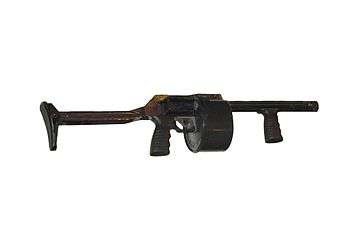Armsel Striker
The Armsel Striker also known as the Sentinel Arms Co Striker-12, Protecta and Protecta Bulldog is a 12-gauge shotgun with a revolving cylinder that was designed for riot control and combat.
| Armsel Striker | |
|---|---|
 | |
| Type | Combat shotgun, Riot control weapon |
| Place of origin | South Africa |
| Service history | |
| In service | 1993–present |
| Used by | South African National Defence Force Israeli Police |
| Production history | |
| Designer | Hilton R. Walker[1] |
| Designed | 1981[1] |
| Specifications | |
| Mass | 4.2 kg (empty) 4.4 kg (loaded) |
| Length | 792 mm (31.18 inch) 508 mm (20 inch) (stock folded) (with 12 in barrel) |
| Barrel length | 191 mm (7.5 in) 305 mm (12 in) 356 mm (14 in) 470 mm (18.5 in) |
| Cartridge | 12 gauge |
| Action | Rotating cylinder |
| Feed system | 12-round revolving cylinder, 7-round cylinder on compact models. |
| Sights | Removable optical sights on Armsel Striker and Protecta. Such sights are holographic, red dot and various others. Iron sights are on all variants. |
History
The Armsel Striker was designed by an ex-Rhodesian national, Hilton R. Walker, in 1981. Walker subsequently emigrated to South Africa, bringing with him the design for the Striker shotgun. His shotgun became a success, and was exported to various parts of the world. Even though it was successful, the shotgun still had its flaws. The rotary cylinder-type magazine was bulky, had a long reload time, and the basic action was not without certain flaws.[2]
Walker redesigned his weapon in 1989, removing the cylinder rotation mechanism, and adding an auto cartridge ejection system. The new shotgun was named the Protecta.[3][4]
A copy of the Striker was made by the US gunmaker Cobray and marketed as the SWD Street Sweeper from 1989 through 1993.[5]
Design and features
The weapon's action is similar to that of a revolver, using a rotating cylinder. Since the Striker uses a conventional double action only trigger and a very large and heavy cylinder (compared to handguns), Walker added a pre-wound clock-work spring to revolve the magazine which proved to make loading the weapon slow, in exchange for a shorter and lighter trigger pull. The design was changed into having a cocking lever on the right side of the barrel.[2][6]
The first designs were criticized as having a slow and cumbersome firing mechanism. The shells had to be individually loaded and then the drum wound by a clockwork mechanism. Shell ejection was by an ejector rod along the right hand side of the barrel. The last version has the clockwork winding mechanism removed, the ejector rod has been replaced by an automatic ejection system and in the rod's place is a cocking lever that winds the drum automatically. The Striker design has a twelve-round magazine capacity and short overall length. Compact variants have 7 rounds.[2][6][7]
Availability in the United States
The Striker and Streetsweeper were declared destructive devices under the National Firearms Act with no sporting purpose by Treasury Secretary Lloyd Bentsen in 1994 and their transfer and ownership is regulated by the Bureau of Alcohol, Tobacco, Firearms and Explosives (ATF).[8]
Variants
- Armsel Striker—this is Hilton Walker's first design.
- Armsel Protecta—An improved version of the Armsel Striker. Readying the weapon for firing was simplified and the weapon's reliability was improved.[3]
- Armsel Protecta Bulldog—An extremely shortened, stockless version of the Armsel Protecta. It is intended for building entry and vehicular duties.[3]
- Sentinel Arms Striker-12—A fully licensed and improved copy of the Armsel Striker for the American market made by Sentinel Arms Co. It was available with an 18-inch barrel and a 7-inch stockless version.[5]
- Cobray/SWD Streetsweeper—A lower-end clone of the Armsel Striker, having a limited parts commonality to the original weapons system.[5]
- Cobray/SWD Ladies Home Companion—A reduced caliber version of the Streetsweeper. The triggergroup is attached to a .410 bore or .45/70 Government drum and barrel.[9]
See also
References
- "patent". Retrieved 1 May 2014.
- Wood, J B (2002). The Gun Digest Book of Firearms Assembly/Disassembly Part V - Shotguns. Iola, Wisconsin: Krause Publications. p. 474. ISBN 978-0-87349-400-7.
- Cutshaw, Charles Q. (28 February 2011). Tactical Small Arms of the 21st Century: A Complete Guide to Small Arms From Around the World. Iola, Wiosconsin: Gun Digest Books. pp. 338–339. ISBN 978-1-4402-2709-7.
- Jones, Richard D.; White, Andrew (27 May 2008). Jane's Guns Recognition Guide 5e. HarperCollins. p. 355. ISBN 978-0-06-137408-1.
- Walker, Robert E. (2013). Cartridges and Firearm Identification. CRC Press. p. 369. ISBN 978-1-4665-8881-3.
- Lee, Jerry (2011). Standard Catalog of Rifles & Shotguns. Iola, Wisconsin: Gun Digest Books. p. 1403. ISBN 978-1-4402-3014-1.
- United States. Bureau of Alcohol, Tobacco, and Firearms (2000). Your guide to federal firearms regulation. Dept. of the Treasury, Bureau of Alcohol, Tobacco, and Firearms. p. 109.CS1 maint: multiple names: authors list (link)
- Smith, Al (November 2007). American Cultures: Readings in Social and Cultural History. Lulu Enterprises Incorporated. p. 167. ISBN 978-1-4357-0160-1.
- Larson, Erik (27 July 2011). Lethal Passage: The Story of a Gun. Knopf Doubleday Publishing Group. p. 196. ISBN 978-0-307-80331-3.
External links
| Wikimedia Commons has media related to Armsel Striker 12. |
- Image of the Cobray/SWD Ladies Home Companion
- Combined Systems – Current manufacturer of Striker Shotguns in the US.